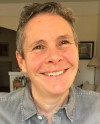 We are very excited to announce that Neuroacanthocytosis Advocacy-USA's successful fundraising drive will directly support a proposed project looking at brain tissue of people who were affected by NA syndromes. NA USA raised $100,000 to support research for one year, under the supervision of Dr. Ruth Walker, which is underway in the lab of Dr. John Crary, in the Pathology Department at Mount Sinai School of Medicine. Many thanks for all who have made donations!
We are very excited to announce that Neuroacanthocytosis Advocacy-USA's successful fundraising drive will directly support a proposed project looking at brain tissue of people who were affected by NA syndromes. NA USA raised $100,000 to support research for one year, under the supervision of Dr. Ruth Walker, which is underway in the lab of Dr. John Crary, in the Pathology Department at Mount Sinai School of Medicine. Many thanks for all who have made donations!
Drs. Walker and Crary have been collaborating for several years now in developing and expanding the Neuropathology Division Brain Bank at Mount Sinai. We are able to perform detailed, systematic examinations of people who suffered from brain disorders, such as NA syndromes, but also including much more common diseases such as Parkinson’s disease and related disorders. In addition to our own studies, we often share these valuable brain tissues with other researchers.
Chorea-acanthocytosis (ChAc) and McLeod syndrome, are genetically distinct, but look very similar when brain tissues are examined down the microscope after death. The brains of people who suffered from a number of other neurodegenerative disorders, such as Parkinson’s, Alzheimer’s, and Huntington’s diseases have been found to contain clumps of protein, both inside and outside neurons. Analysis of the protein clumps has been informative in driving research into these disorders. NA syndromes are unusual in that such protein clumps have not been identified. In fact, the main observations in people with NA has been that there is loss of brain cells in specific regions, and a lot of scar tissue, known as “fibrosis”. We propose to use the latest neuropathological techniques, informed by recent research in the field such as that in yeast and other organisms, to look for other clues as to what is killing brain cells in these diseases. As part of this project Dr. Gabriel Miltenberger will be looking at constituents of lipids (fats) in the brain, as abnormalities of these may underlie the abnormal red cell shapes, and may also provide insights into brain cell damage. We are especially excited about the recent work from Drs. Jae-Sook Park and Aaron Neiman at Stony Brook, who have found that the two proteins affected in McLeod syndrome and ChAc appear to be in the same locations in yeast cells.
We will be collaborating with all of our colleagues in the field, and will be brainstorming at the upcoming 10th International Neuroacanthocytosis Meeting in March, to maximize the insights and advances that we can obtain from our research.
This project would not be possible without the generous gifts of people affected by NA syndromes, who have donated their brains and other body tissues to us to further our understanding of these awful diseases. Our gratitude also extends, of course, to their families, who work with us ahead of time to deal with the necessary paperwork and other logistics, and who make the critical phone call to us when the time comes, so that we can move quickly to get the most information from this valuable donation.